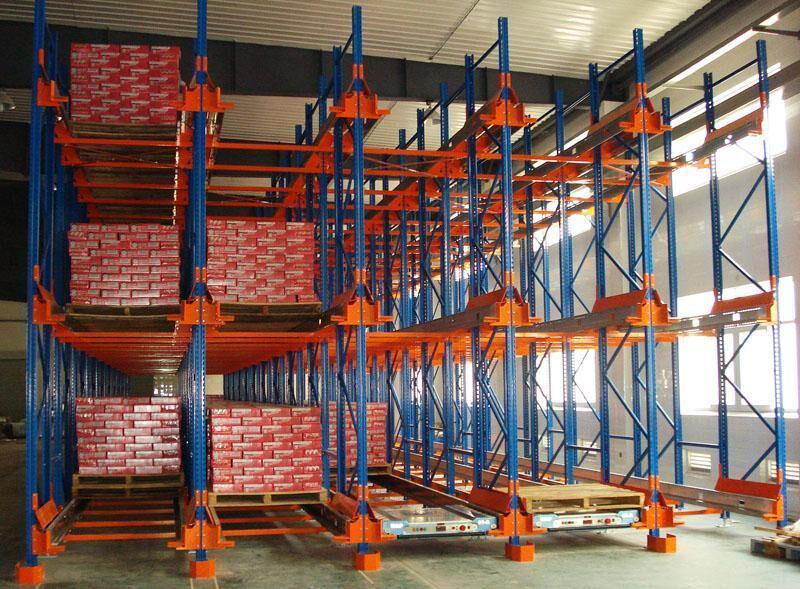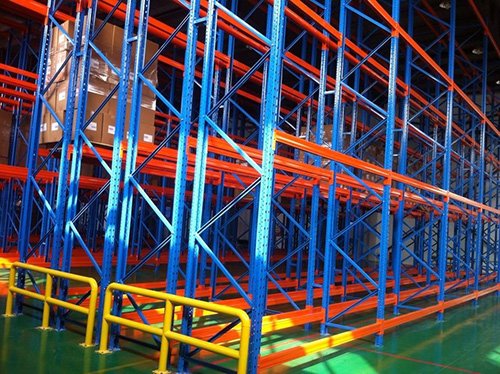In the relentless pursuit of warehouse optimization, maximizing storage density while maintaining accessibility and throughput is the holy grail. Enter Shuttle Pallet Racking, a semi-automated high-density storage solution that has transformed how businesses handle large volumes of homogeneous palletized goods. Moving beyond the limitations of traditional selective racking, shuttle pallet racking leverages technology to store pallets deep within lanes, accessed by autonomous vehicles operating within the rack structure itself. This guide delves deep into shuttle pallet racking, exploring its core principles, operation, advantages, applications, and critical considerations, providing a comprehensive understanding of this powerful warehousing tool. Understanding shuttle pallet racking is essential for any operation seeking significant space savings and efficiency gains.

1. Understanding the Core Functionality and Components of Shuttle Pallet Racking
At its heart, shuttle pallet racking is a high-density storage system designed for Last-In, First-Out (LIFO) or, less commonly, First-In, First-Out (FIFO) inventory management. Unlike traditional systems where forklifts navigate aisles to access each pallet location directly, shuttle pallet racking employs deep storage lanes, often 10, 20, 30 pallets deep or more.
The key components define the system:
Deep Storage Lanes: These are the backbone, constructed from robust pallet racking frames supporting rails upon which pallets rest. Each lane is dedicated to a single SKU (Stock Keeping Unit).
The Shuttle Car: This is the intelligent, battery-powered robotic vehicle that operates inside the storage lane. Controlled wirelessly, it travels along the lane rails, performing the critical tasks of lifting, transporting, and placing pallets within the depth of the rack.
Transfer Cars (Optional but Common): For multi-level shuttle pallet racking systems, transfer cars (also called lifts or elevators) operate in the front aisle. They receive pallets from forklifts, transport them vertically and horizontally to the correct level and lane entrance, and hand off the pallet to the awaiting shuttle car (or vice versa for retrieval).
Charging Stations: Strategically placed stations allow shuttle cars to autonomously dock and recharge their batteries, ensuring continuous operation.
Warehouse Management System (WMS) Integration: While not a physical component, seamless integration with the WMS is crucial. The WMS directs the shuttle system, telling it exactly where to store incoming pallets and where to retrieve specific pallets from within the deep lanes. It manages lane assignments and optimizes the flow.
The fundamental principle of shuttle pallet racking is the decoupling of the forklift from the deep storage process. The forklift operator's role simplifies to delivering pallets to the lane entrance (or transfer car) and retrieving them from the same point. The shuttle car handles all the intricate movement deep within the lane.
2. How Shuttle Pallet Racking Operates: The Workflow
The operation of a shuttle pallet racking system involves a coordinated dance between personnel, forklifts, transfer cars (if present), shuttle cars, and the WMS:
Storage (Putaway):
A forklift brings a pallet to the designated lane entrance point at the front of the rack.
If a transfer car is used, the forklift places the pallet onto the transfer car platform. The transfer car then moves vertically/horizontally to the correct storage level and aligns with the target lane entrance.
The shuttle car, positioned inside the lane, receives the pallet either directly from the forklift or from the transfer car.
Guided by the WMS, the shuttle car transports the pallet deep into the lane, finds the first available position (for LIFO) or the deepest position (for FIFO), deposits the pallet, and returns to the front. The WMS records the exact pallet location within the lane.
Retrieval (Picking):
The WMS receives an order requiring a pallet from a specific SKU lane.
The system instructs the shuttle car in that lane to retrieve the required pallet. In LIFO systems, this is typically the front-most pallet (the last one stored). In FIFO, it retrieves the pallet at the very back.
The shuttle car travels to the pallet position, lifts it, and transports it to the lane entrance.
The shuttle car presents the pallet to the transfer car (if used) or directly to the waiting forklift operator.
The transfer car delivers the pallet to the ground level or designated pick-up point, where the forklift removes it for dispatch or order fulfillment.
The WMS updates inventory records.
This process significantly reduces forklift travel and maneuvering within the aisles, minimizes operator involvement in the deep storage process, and dramatically speeds up putaway and retrieval cycles for high-volume SKUs.

3. Maximizing Space Utilization: The Density Advantage
The most compelling benefit of shuttle pallet racking is its unparalleled ability to maximize storage density within a given warehouse footprint:
Elimination of Wide Aisles: Traditional selective racking requires wide aisles (often 11-13 feet or more) for forklifts to maneuver, turn, and access pallets. Shuttle pallet racking only requires a single, relatively narrow "working aisle" at the front of each set of lanes. The depth of the lanes themselves consumes what would otherwise be wasted space from multiple aisles.
Deep Lane Storage: By storing pallets 10, 20, 30 deep or more, shuttle pallet racking utilizes the cubic volume of the warehouse far more effectively than any selective system. The storage depth is limited primarily by building size and structural considerations.
Increased Pallet Positions: The combination of deep lanes and minimized aisle space typically results in a 50-100% increase (or more) in pallet positions compared to conventional selective racking within the same building envelope. This directly translates to deferred capital expenditure on new warehouse construction or the ability to consolidate operations from multiple facilities.
Optimized Cube Usage: Shuttle pallet racking systems can be built very high, maximizing vertical space utilization, similar to standard pallet racking. The synergy of height and depth creates exceptional density.
Reduced Non-Value-Added Space: By focusing only on a single access point per lane set, the system minimizes the "air" or unutilized space inherent in systems requiring multiple access aisles.
For businesses facing soaring real estate costs or constrained by existing building size, the density offered by shuttle pallet racking provides a powerful solution.
4. Enhancing Efficiency, Productivity, and Automation
Beyond space savings, shuttle pallet racking delivers significant operational advantages:
Increased Throughput: Shuttle cars operate autonomously and much faster within the lanes than a forklift could navigate aisles and position pallets deep in a lane. Multiple pallets can be retrieved or stored in sequence rapidly once the shuttle is in position. Transfer cars further parallelize operations across multiple levels.
Reduced Forklift Traffic & Labor Costs: Forklift operators spend significantly less time traveling long distances and performing intricate maneuvers deep within racks. Their role becomes more efficient: drop off at the lane entrance, pick up from the lane entrance. This allows fewer forklifts and potentially fewer operators to handle the same or greater volume, reducing labor costs and fuel/electricity consumption. It also enhances safety by reducing forklift traffic congestion.
24/7 Operation Potential: Shuttle cars can operate autonomously during unmanned shifts (e.g., nights, weekends), performing putaway or retrieval tasks scheduled by the WMS, maximizing asset utilization.
Improved Accuracy: WMS control and automated movement within the lanes drastically reduce human errors associated with manual putaway and retrieval in deep lanes. The system knows exactly where every pallet is located.
Enhanced Safety: Minimizing forklift travel within aisles and eliminating the need for forklifts to enter deep racking structures significantly reduces the risk of accidents, rack damage, and product damage. Operators work in a more controlled front-aisle environment.
Consistent Performance: Shuttle cars work tirelessly at a consistent pace, unaffected by operator fatigue or shift changes, leading to predictable and reliable throughput.
The automation inherent in shuttle pallet racking transforms warehouse workflows, boosting productivity and operational resilience.
5. Ideal Applications and Industries for Shuttle Systems
Shuttle pallet racking excels in specific operational environments:
High-Volume SKUs with Low Variety: The system is most cost-effective when storing large quantities of a limited number of SKUs. Each lane is typically dedicated to a single SKU. Operations with thousands of unique SKUs and low pallet quantities per SKU are generally not suitable.
Homogeneous Pallet Loads: Pallets stored within a single lane must be identical in size, weight, and product type to ensure smooth operation of the shuttle car.
LIFO or FIFO Inventory Management: The system naturally supports LIFO (common for bulk storage, manufacturing raw materials). FIFO is achievable but requires more sophisticated shuttle/WMS coordination and potentially different lane configurations.
Space-Constrained Warehouses: Where real estate is expensive or expansion is impossible, shuttle pallet racking unlocks massive hidden capacity.
Cold Storage Facilities: The density gains are exceptionally valuable in expensive cold storage environments. Reduced forklift traffic also minimizes heat infiltration when doors open. The ability to automate movements in extreme cold is a major plus.
Beverage Industry: High volume, large SKU quantities, and constant turnover make beverages an ideal fit.
Food & Grocery: Similar to beverages, handling large volumes of stable product lines efficiently.
Manufacturing: Perfect for storing large quantities of raw materials or finished goods requiring bulk storage.
Distribution Centers: For high-throughput DCs handling large volumes of specific product lines.
Businesses experiencing rapid growth or seasonal peaks also benefit from the scalable density and throughput shuttle pallet racking provides.
6. Critical Considerations and Investment Factors
Implementing shuttle pallet racking is a significant investment requiring careful analysis:
Higher Initial Investment: The cost of the racking, shuttle cars, transfer cars (if needed), sophisticated WMS integration, and installation is substantially higher than traditional selective racking. A thorough ROI analysis, factoring in space savings, labor reduction, and productivity gains, is essential.
SKU Suitability: As mentioned, the system is less flexible for operations with a vast number of SKUs and low pallet counts per SKU. Slow-moving items occupying deep lanes can be inefficient.
Dependence on Technology & Maintenance: The system relies heavily on the shuttle cars, transfer cars, software, and network connectivity. Downtime can halt operations. A robust maintenance plan and readily available technical support are crucial. Battery management for the shuttles is also key.
LIFO Bias: While FIFO is possible, LIFO is the most straightforward and efficient operating mode. Ensure this aligns with your inventory requirements.
System Design Complexity: Designing an optimal shuttle pallet racking system requires specialized expertise. Factors include lane depth, number of shuttles per level/lane set, transfer car requirements, charging strategies, and seamless WMS integration.
Building Requirements: The structure must support the significant weight of fully loaded deep lanes, often requiring specific floor slab strength and column spacing evaluations. Ceiling height must accommodate the desired rack height and transfer car mechanisms.
Implementation Time & Disruption: Installation is more complex than standard racking and may cause more significant operational disruption during the transition phase.
Shuttle pallet racking represents a powerful leap forward in warehouse storage technology, offering unparalleled density, significant operational efficiencies, and enhanced safety for the right applications. By automating the movement of pallets within deep storage lanes, it liberates forklifts and operators from inefficient tasks, boosts throughput, and unlocks the hidden potential within existing warehouse footprints.
However, it's not a universal solution. The substantial investment demands a clear business case built on high volumes of homogeneous SKUs where space savings and productivity gains will deliver a strong return. Operations characterized by extreme SKU variety and low pallet depth per SKU may find the system less advantageous.
For businesses in industries like food and beverage, cold storage, manufacturing, or bulk distribution – where maximizing pallet positions and streamlining the flow of high-volume goods is paramount – shuttle pallet racking is a transformative solution worthy of serious consideration. Careful planning, expert design, and robust maintenance are the keys to unlocking the full potential of this sophisticated high-density storage system. If your challenges center on space constraints and handling large volumes efficiently, shuttle pallet racking could be the key to your warehouse optimization success.







